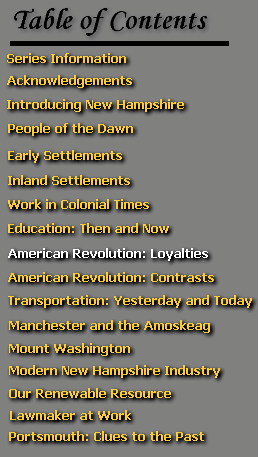SUMMARY
 On
April 21, 1775, a post rider gallops into the busy New Hampshire town square
to announce the urgent news about the battles of Lexington and Concord
(Mass.) to the gathering crowd. The men in the astonished and agitated
crowd begin to sign up for the militia. They even shout down one man who
tries to speak in defense of the king's troops. On
April 21, 1775, a post rider gallops into the busy New Hampshire town square
to announce the urgent news about the battles of Lexington and Concord
(Mass.) to the gathering crowd. The men in the astonished and agitated
crowd begin to sign up for the militia. They even shout down one man who
tries to speak in defense of the king's troops.
The lesson focuses on Collin
Moffett and his family during the early days of the Revolutionary War.
Collin is the first of the townsmen to enlist. After he announces his enlistment
to his family, we see the opposition of his loyalist father-in-law and
the concern and consternation of his wife and children.
Collin's militia soon marches
to Charlestown, Massachusetts, to join other patriot troops near Boston.
While the American soldiers wait, the scene shifts back to the Moffett
farm to show what life is like on the home front. Collin's wife and children
are busy attending to the daily work of the planting season. The divided
loyalties among the townspeople are seen in an incident between some patriotic
citizens and a wealthy businessman who supports England.
Collin is severely wounded
at the Battle of Bunker Hill.
He returns home, unable to walk or to work his farm any longer. He is one
of many New Hampshire men whose sacrifices won America its freedom.
OBJECTIVES
1. To point out the
role New Hampshire citizens played in the Revolutionary War, especially
in the Battle of Bunker Hill.
2. To show the division
of loyalties among citizens in the colonies toward the War.
3. To give students
a feeling of what life was like during the Revolution in New Hampshire,
for people who were not actually actively involved in the War.
PRE-VIEWING ACTIVITIES
1. On the map, locate
Concord, Lexington, and Charlestown, Massachusetts.
2. What do you think
it would have been like to go to war in Revolutionary times? Does anyone
have relatives who are soldiers now or who were in a war? How did you feel
about having your relative in a foreign country (or in another part of
this country)? What must it have been like for the family to have a father
or brother in the Revolutionary War with no communication to find out what
was happening?
3. What was a Tory?
In all wars, there are some people who oppose the war. Does this mean that
such people are traitors? What about the people who opposed the Vietnam.War?
If you had been alive during the Revolutionary War, would you have been
a Tory or a patriot? Why? What made you decide?
POST-VIEWING ACTIVITIES
1. Show a picture
of a Revolutionary soldier and a modern soldier. Discuss the differences
and similarities in his clothes and equipment.
2. Were many New Hampshire
colonists Tories? Find out. Why were some people loyal to the King? What
happened to the Tories when the colonists won the war?
3. Were there any
men who served in the Revolutionary War from your town or family? Find
out all you can about them and report to the class.
4. Imagine that you
are the wealthy merchant in the lesson. How would you react to the news
of Concord and Lexington? Why would you argue against going to war with
the British?
5. Imagine how Jonathan
felt during the battle. How did his family feel when he was away? How did
they feel when he came back from war? If you were Eben, Jonathan's son,
how do you think you might feel when you saw your father return from the
war wounded?
6. Write a story or
report about a New Hampshire patriot or statesman of Revolutionary times.
Collect all of the stories into a Who's Who of the American Revolution.
VOCABULARY
-
musket
-
militia
-
tar-and-feather
-
powder
-
hewn
-
vat
-
flints
-
muster
-
paralyzed
PLACES TO VISIT
-
Fort William & Mary, New
Castle, N.H. (now Fort
Constitution)
-
General John Sullivan Home,
monument and grave on Route 108 beyond Durham Falls
-
Sullivan and Scammell Memorial
Bridges on Route 4 from Portsmouth to Durham
-
The Wyman Tavern, 339 Main Street,
Keene
-
General John Stark House, 2000
Elm Street, Manchester
PLACES TO KNOW
-
Charlestown,
Massachusetts
-
Bunker Hill, Massachusetts
-
Lexington,
Massachusetts
-
Concord,
Massachusetts
|




